Abstract
Three hundred 1-day-old avian broilers were fed on a basic diet (0.2 mg/kg selenium) or the same diet amended to contain 1, 5, 10, and 15 mg/kg selenium supplied as sodium selenite (n = 60/group). In comparison with those of 0.2 mg/kg selenium group, the percentages of annexin V-positive splenocytes were increased in 5, 10, and 15 mg/kg selenium groups. TUNEL assay revealed that apoptotic cells with brown-stained nuclei distributed within the red pulp and white pulp of the spleens with increased frequency of occurrence in 10 and 15 mg/kg selenium groups in comparison with that of 0.2 mg/kg Se group. Sodium selenite-induced oxidative stress in spleens of chickens was evidenced by decrease in glutathione peroxidase, superoxide dismutase, and catalase activities and increase in malondialdehyde contents. The results indicate that excess dietary selenium in the range of 5–15 mg/kg of feed causes oxidative stress, which may be mainly responsible for the increased apoptosis of splenocytes in chickens.



Similar content being viewed by others
References
Gladyshev VM, Hatfield DL (1999) Selenocysteine-containing proteins in mammals. J Biomed Sci 6:151–160
Rotruck JT, Pope AL, Ganther HE et al (1973) Selenium: biochemical role as a component of glutathione peroxidase. Science 179:588–590
Spallholz JE (1994) On the nature of selenium toxicity and carcinostatic activity. Free Radic Biol Med 17:45–64
Kramer GF, Ames BN (1988) Mechanisms of mutagenicity and toxicity of sodium selenite (Na2SeO3) in Salmonella typhimurium. Mutat Res 201:169–180
Spallholz JE (1997) Free radical generation by selenium compounds and their prooxidant toxicity. Biomed Environ Sci 10:260–270
Seko Y, Imura N (1997) Active oxygen generation as a possible mechanism of selenium toxicity. Biomed Environ Sci 10:333–339
Terada A, Yoshida M, Seko Y et al (1999) Active oxygen species generation and cellular damage by additives of parenteral preparations: selenium and sulfhydryl compounds. Nutrition 15:651–655
Spallholz JE, Palace VP, Reid TW (2004) Methioninase and selenomethionine but not Se-methylselenocysteine generate methylselenol and superoxide in an in vitro chemiluminescent assay: implications for the nutritional carcinostatic activity of selenoamino acids. Biochem Pharmacol 67:547–554
Lu J, Jiang C, Kaeck M, Ganther H et al (1995) Dissociation of the genotoxic and growth inhibitory effects of selenium. Biochem Pharmacol 50:213–219
Lu J, Kaeck M, Jiang C, Wilson AC et al (1994) Selenite induction of DNA strand breaks and apoptosis in mouse leukemic L1210 cells. Biochem Pharmacol 47:1531–1535
Zhou N, Xiao H, Li TK et al (2003) DNA damage-mediated apoptosis induced by selenium compounds. J Biol Chem 278:29532–29537
Kim YS, Jhon DY, Lee DY (2004) Involvement of ROS and JNK1 in selenite-induced apoptosis in Chang liver cells. Exp Mol Med 36:157–164
Letavayová L, Vlčková V, Brozmanová J (2006) Selenium: from cancer prevention to DNA damage. Toxicology 227:1–14
Peng X, Cui H, Deng J et al (2011) Histological lesion of spleen and inhibition of splenocyte proliferation in broilers fed on diets excess in selenium. Biol Trace Elem Res. doi:10.1007/s12011-010-8679-0
Peng X, Cui Y, Cui W et al (2009) The decrease of relative weight, lesions, and apoptosis of bursa of Fabricius induced by excess dietary selenium in chickens. Biol Trace Elem Res 131(1):33–42
Peng X, Cui H, Cui Y et al (2011) Lesions of thymus and decreased percentages of the peripheral blood T-cell subsets in chickens fed on diets excess in selenium. Hum Exp Toxicol. doi:10.1177/0960327111403176
Bradford MM (1976) A rapid and sensitive method for the quantitation of microgram quantities of protein utilizing the principle of protein-dye binding. Anal Biochem 72:248–254
Chen T, Cui HM, Cui Y et al (2010) Decreased antioxidase activities and oxidative stress in the spleen of chickens fed on high fluorine diets. Hum Exp Toxicol. doi:10.1177/0960327110388538
Miksa IR, Buckley CL, Carpenter NP et al (2005) Comparison of selenium determination in liver samples by atomic absorption spectroscopy and inductively coupled plasma-mass spectrometry. J Vet Diagn Invest 17:331–340
Weiller M, Latta M, Kresse M et al (2004) Toxicity of nutritionally available selenium compounds in primary and transformed hepatocytes. Toxicology 201:21–30
Shen CL, Song W, Pence BC (2001) Interactions of selenium compounds with other antioxidants in DNA damage and apoptosis in human normal keratinocytes. Cancer Epidemiol Biomarkers Prev 10:385–390
Garberg P, Stahl A, Warholm M et al (1988) Studies of the role of DNA fragmentation in selenium toxicity. Biochem Pharmacol 37:3401–3406
Biswas S, Talukder G, Sharma A (1997) Selenium salts and chromosome damage. Mutat Res 390:201–205
2011Biswas S, Talukder G, Sharma A (2000) Chromosome damage induced by selenium salts in human peripheral lymphocytes. Toxicol In Vitro 14:405–408
Combs GF Jr, Gray WP (1998) Chemopreventive agents: selenium. Pharmacol Ther 79:179–192
Seboussi R, Faye B, Alhadrami G et al (2010) Selenium distribution in camel blood and organs after different level of dietary selenium supplementation. Biol Trace Elem Res 133(1):34–50
Mona MAH (2011) Toxicological study of sodium selenite on fetal development and DNA fragmentation in liver cells of pregnant rats. Biol Trace Elem Res. doi:10.1007/s12011-010-8682-5
Halliwell B, Chirico S (1993) Lipid peroxidation: its mechanism, measurement, and significance. Am J Clin Nutr 57(5 Suppl):715S–725S
Acknowledgment
This study was supported by Program for Changjiang Scholars and Innovative Research Team in University (IRT 0848) and Education Department of Sichuan Province (09ZZ017).
Author information
Authors and Affiliations
Corresponding author
Rights and permissions
About this article
Cite this article
Peng, X., Cui, H., He, Y. et al. Excess Dietary Sodium Selenite Alters Apoptotic Population and Oxidative Stress Markers of Spleens in Broilers. Biol Trace Elem Res 145, 47–51 (2012). https://doi.org/10.1007/s12011-011-9160-4
Received:
Accepted:
Published:
Issue Date:
DOI: https://doi.org/10.1007/s12011-011-9160-4




